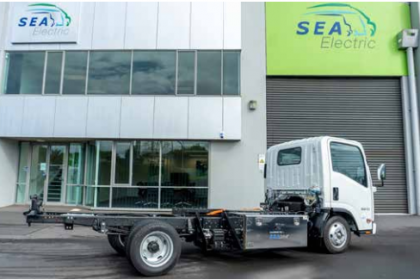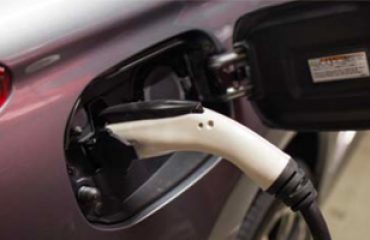
EV Talk NZ interview Stephen Fairweather, our NZ General Manager, about electric trucks being assembled in New Zealand by SEA Electric.
“Kiwi-Build for EV Trucks”, pg 11 & 12 of EV Talk June 2019 READ MORE
Electric trucks are being assembled in New Zealand. Moreover, they have been successful on the road for some time. Absorb that for a moment. In fairness, they are being finished in New Zealand,
under the auspices of an Australian company, with batteries from China and motors from Canada. Still, trucks that would otherwise be spewing diesel fumes on our road are instead silently
getting around on electricity.
The trucks, and soon to come vans, are the work of Melbourne-based SEA Electric. The company has quickly developed a strong reputation for developing electric-propulsion drivetrains for a range of common truck platforms – to the point where they developed Isuzu Australia’s electric truck concepts.
General manager for SEA Electric New Zealand, Stephen Fairweather, is now leading the expansion of the brand within New Zealand – where it is finding a ready market.
“We have got a lot of vehicles in the pipeline at the moment,” Fairweather explains. “Currently there are seven vehicles already on the road. Four of them were locally built in Auckland. Others being built are all sorts for various markets.”
Councils are finding electric propulsion to be a boon for the relatively short, stop-start trips that kind of vehicle endures. The locally assembled ones were put together by body-builder Manco Environmental at its East Tamaki facility. All up a further 18 vehicles are in the pipeline, including a prominent, EECA-backed contract with Countdown for their home delivery trucks.
“They have got five coming,” Fairweather says. “We built the first one in Melbourne to make sure all the engineering was right and then shipped that over here. CAL Isuzu is building the other
four in Hamilton.”
CAL Isuzu is building several vehicles for SEA, part of how it prefers to work with truck brands here. Rather than its own factory, it works with partners already set up with workshops to handle the conversions. CAL is handling Isuzu product in the North Island, while Blackwells will handle it in the South Island – the latter building some units for Foodstuffs.
The vehicles arrive in New Zealand with their diesel drivetrain intact. It is removed from the truck and taken into parts stock by the dealer. Not that Isuzu is the only brand they will work
with. There are also IVECO and Hino trucks with SEA drivetrains installed on the road here. “Our system’s designed to fit into a standard rigid chassis. So we don’t mind what brand of truck it is,” Fairweather explains.
For operators, that means they can stick with a supplier and chassis they are comfortable with, speeding integration into fleets.
The vehicles are very configurable, with batteries that range from 70kWh to 216kWh on offer. SEA’s battery density has been growing over time, providing more range with no additional bulk and little extra weight. Systems are modular, with Fairweather explaining one customer is in the process of up-sizing their battery, their existing unit able to be sold to a new customer at a reduced rate.
A similar build model will be taken with the arrival of their electric delivery and minibus vans. They are based on a Chinese van that looks similar but is not the same as, the outgoing generation Hiace. Action Manufacturing will handle the drivetrain fitment to the “glider” bodies. The four-tonne van will retail for $89,990 and the 15-seat minibus for $99,990. A number are already on order, three going to Alsco to handle laundry and another to Sanford to carry chilled fish. The latter will use a chiller powered off the traction battery, making it entirely electric.
So how far will a SEA Electric unit go? That depends on the size of the vehicle and the configuration the user chooses. The small delivery trucks will go 200-260km on a charge, and the rubbish trucks a similar distance – though with the addition of a considerable number of uplifts of bins. The vans hit up to 350km. Ranges like that take the vehicles beyond simple “last mile” status, with Fairweather explaining one client is working to have an electric truck do a Rotorua to Taupo return trip in the morning, then Rotorua to Tauranga in the afternoon. Moreover, that is without DC fast charging.
SEA has not yet equipped its vehicles for the technology, working instead on the basis that its commercial clients will have, or can fit, 32 amp three-phase charging, allowing for overnight fills or top-ups between jobs.
“We end up with probably the biggest charging infrastructure in the world, actually,” Fairweather explains. “Because just about every commercial environment’s got a 32 amp PDL 56 series
screwed to the wall.”
Charging is relatively fast, and so is payback. For a medium-size electric delivery truck, Fairweather says payback on the additional investment comes in around two-and-ahalf years. The savings are not just from fuel. Service costs are lower, particularly brakes. With the large rubbish trucks, four brake changes were scheduled a year – the electric version only required one. “And according to them, it didn’t really need doing; they just took the wheels off to have a look to see what was going on and decide of they’d change them while they were at it.” impact on tyre use – around 15-20%.
“That one we weren’t quite expecting,” Fairweather says. “We think it is because of the linear nature of the motor – rather than the horrible diesel whack on them.”
Smooth operator We got the chance to go for a ride around Otahuhu in one of Sea Electric’s Isuzu NLRbased small trucks, this one headed for a life delivering groceries for Countdown. With its electric drivetrain well behind you, the SEA truck is even quieter than the other electric commercial we have experienced, the LDV EV80. Without the weight of a body behind us, there was
some jiggle to the way the truck rode, but otherwise, it was very smooth – taking off the power delivery curve appears to have been programmed to perfection. The Isuzu demonstrates
one of those critical reasons such conversions work so well. There is nothing in the cab of this truck that gives away the game as to what it is – other than the silence. It is just a truck, with all
the convenience and comfort levels Isuzu’s experience have given it. Even the transmission shifter is the same.




